► All-new large people carrier from VW
► Standalone product, no longer Transporter-based
► Lots of tech, clever interior, PHEV power
The Volkswagen Caravelle was hardly a sexy beast, but it did the van-based people carrier thing extremely well. Now, though, the time has come for van and people carrier to part ways in the VW line-up, thanks to this brand new – and perhaps confusingly named – Multivan model.
The new VW Multivan replaces the Caravelle. Instead of being based on the Transporter van and despite being codenamed the T7, the Multivan is now a standalone MPV based on the ever-versatile MQB platform.

As a result of this it has a) a slightly bulbous nose, and b) an absolute stack of the latest technology. Especially in the realm of safety, with Car2X and VW’s most up-to-date pseudo autonomous driving chops, IQ.DRIVE, among the 34 available driver assistance systems.
But more importantly, if you want a big bus that’ll seat seven in comfort and still carry their luggage, the Multivan has some new tricks of this kind stuffed into its voluminous backside as well. Not to mention a plug-in hybrid drivetrain and standard-fit DSG transmission.
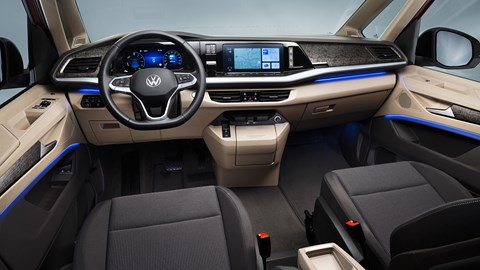
Why is it called the Multivan if it isn’t a van?
The thing is that the VW Caravelle was only ever called the Caravelle in the UK. Elsewhere in Europe, Caravelle is just a trim level in a model range already called the Multivan – or Bulli, if your one of the legions of affectionate German fans.
For the UK’s purposes, switching to the Multivan name now provides a clean break from the previous models, underlining that it no longer has any relationship to the VW Transporter. Although it is still being built be Volkswagen Commercial Vehicles, rather than VW’s car arm.
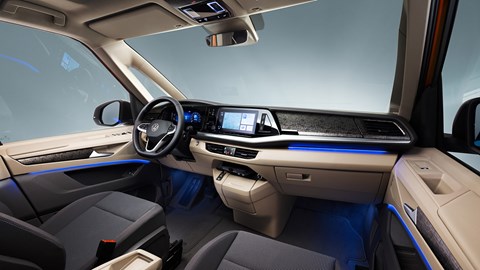
Size-wise, the Multivan is slightly lower on the outside than the old Caravelle, but is roomier on the inside – especially if you opt for the panoramic roof. It comes it two lengths, just like the Caravelle did, and has a totally flat floor inside.
All five of the rear seats can be removed, should you need the maximum 1,844 litres of space the base version provides. But even with them all still installed there’s a substantial 469-litre boot.
What makes it better than the Caravelle?
Instead of two middle seats and a rear bench, all five of the occupants in the back now get their own individual chair.
These all slide on tracks set into the floor and the middle two can be rotated to face the rear, creating that mobile lounge you’ve always wanted. Unlike with some competitors, you don’t need to take the seats out to rotate them, but even if you did, you’d benefit for them all being 25% lighter than before.
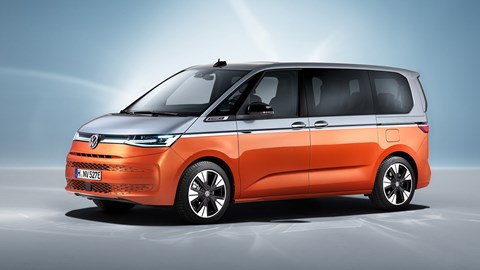
This makes them much easier to remove, not least because you no longer have to deal with the incredibly weighty rear bench. VW’s crack demo can do the job in less than five seconds (according to a video shown during the press conference); expect it to take your family a little longer, but for it to be much more manageable than it ever was in the Caravelle.
Final mention in the back goes to the new table design, which is height adjustable, foldable and doubles as storage – and can now be pushed all the forward to sit between the front seats as well.
And if I have to drive, rather than be driven?
Then we hope you like screens. Lined-up alongside the 10.25-inch digital instrument cluster is a 10.0-inch infotainment system, mounted high so you don’t have to look away from the road too long. There’s also a head-up display option, for the first time on a VWCV-built vehicle.
The infotainment comes in entry-level ‘Ready 2 Discover’ flavour, plus the perhaps more familiar Discover Media and Discover Pro options – the overly touchified set-ups many of us have already moaned about in the Golf and other recent VW models. You get used to them, and they do all have a built-in eSIM for connectivity.
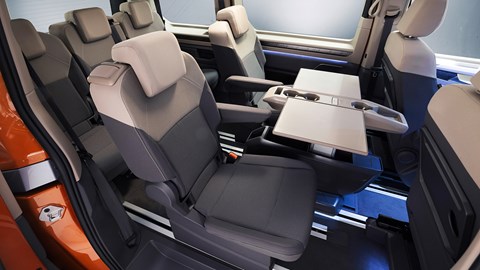
Speaking of which, Volkswagen’s basic We Connect suite is free for life, but the more feature-rich We Connect Plus will require a continuing subscription after the first three years.
Screens aside, the dashboard has a kind of van-y look about it, which should be good for practicality. You’ve probably noticed there isn’t a traditional gear selector or hand brake, either – instead these are all electronic, hence VW only offering the Multivan with DSG automatics.
What’s under that big bonnet?
The launch engines coming in 2021 are all petrols, lead by the eHybrid.
This is a plug-in hybrid that combines an 85kw (114bhp) electric motor, 13kWh battery pack and 139bhp 1.4-litre TSI to achieve a total system output of 215bhp and an as yet unspecified electric-only driving range for ‘short, urban trips’.
If you don’t feel the need to fork out for that, the other options are a 1.5-litre TSI with 148bhp and a 2.0-litre TSI with 201bhp. We can’t imagine the fuel economy on these will be anything but eye-watering, but at least there’s no dirty diesel, eh?
Not until 2022, anyway, when a 148bhp 2.0-litre TDI will be added to the Multivan configurator. This will almost certainly be one of the clever new ‘twin-dosing’ units VW is already using in the Caddy, adding a double-shot of AdBlue to the exhaust to reduce those nasty NOx emissions further.
Every Caravelle comes with DSG; the eHybrid uses a specially modified six-speed unit, the other petrols the regular seven-speed version.
This thing is presumably going to cost me an arm and a leg?
The Caravelle was never a cheap vehicle, that’s for sure – and while there’s no Multivan pricing just yet, as it doesn’t go on sale until later in 2021, we fully expect it to be similarly expensive.
On the plus side, VW has a long history of doing these people moving boxes extremely well, and we don’t doubt that having car components as the starting point instead of van ones will see driving dynamics and comfort take a big step forward.
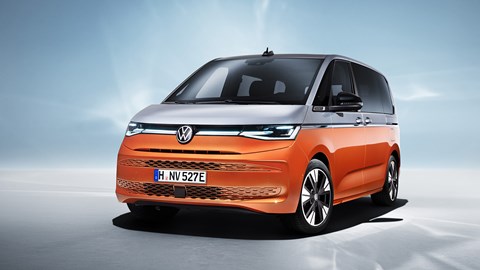
So, there really won’t be a proper van version?
The current T6.1 Transporter carries on until 2023, when that’s set to be replaced by an all-new van based on Ford’s next-generation Transit Custom [].
In the meantime, 2022 is scheduled to see the launch of the production version of the all-electric ID.Buzz. Likely to be called the ID.7, this will sport retro-futuristics looks, come in van and passenger variants, and is almost the same size as both Multivan and Transporter.
Presumably Volkswagen knows what it’s doing.
You can read more about the Multivan and the current Volkswagen Transporter on our sister site Parkers
Read our review of VW’s sporty T-Roc R
Our rundown of the best hybrid SUVs on sale
Future electric cars: upcoming EVs to look out for